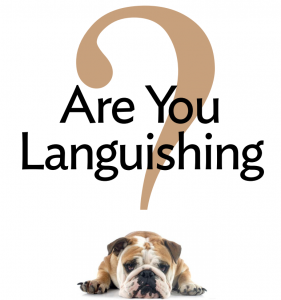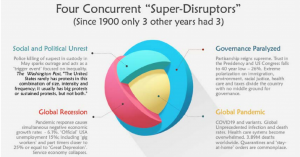Are You Languishing?
By Charles Grantham PhD, MSH, FAIS, APF and Rebecca Ryan, APF
*This is an article from the Fall 2021 issue of Contentment Magazine.
Post-Pandemic Context
To be in a state of languishing. This is a typical person’s psychological response to moving out of pandemic lockdowns and social interaction restrictions. In our view, it parallels the grieving process (Clarke, 2021).1 What are we grieving? Our loss of ‘normalcy.’ We lost it, we know it’s not coming back to 2019, and it hurts. Languishing is somewhere between bargaining and depression in the grief process. Our intent here is to help readers move more quickly through the grieving process.
Formal Definition
In formal English, “languishing”2 is a state of being listless, decreased vitality, dispirited, or assuming an expression of grief or emotion appealing for sympathy. In today’s common parlance, it means ‘to be in a funk’ or just feeling ‘meh.’
In a real sense, what is it?

Psychologically, it is between ‘flourishing’ and ‘depression.’
Unfortunately, languishing, if left unattended, can lead to emotional stress and significant mental health issues. Consider, “The risk of a major depressive episode was two times more likely among languishing than moderately mentally healthy adults, and nearly six times greater among languishing than flourishing adults.”3
Another by-product of a languishing state is a precursor to burnout. We’re all familiar with job burnout.4
Callout box or special emphasis, needs to follow directly after previous paragraph
“Burnout is characterized by emotional exhaustion, cynicism and ineffectiveness in the workplace, and by chronic negative responses to stressful workplace conditions.”
Remaining in a prolonged state of extreme stress is not conducive to good mental health. This is one of the reasons we are calling attention to languishing. Even after we have been vaccinated, social distancing protocols are relaxed, and we return to a partially co-located workplace, the post-pandemic effects will remain and perhaps intensify.
We submit that proactive action is required. We call this process of ‘getting ahead of the curve’ “strategic foresight” — a technique routinely practiced by professional futurists. We think it is time this methodology is brought to the healthcare field and the practice of wellbeing.
Why Today?
It is interesting to note that the use of ‘strategic foresight’ 5 brought us to discover and explore ‘languishing.’ We routinely practice searching for ‘weak signals’6 which presages more significant events and trends in the medium and long term.
In early 2020 (before COVID became the meme of the day in mass media), our environmental scans revealed a set of ‘nested’ weak signals, all converging on the social-psychological impact of a severe global pandemic. The Spanish Influenza in 1918, the AIDS epidemic in the 1980s, and the Ebola virus were lessons from history, but these signals seemed stronger and were amplifying each other. Here’s what we saw coming.

So, why now? Why today? It is the confluence of four major societal disruptors which given rise to a unique social-psychological environment. No wonder we are stressed to the limit. One note is that these effects are ‘nested.’ That is, they reinforce each other. Disease begets economic recession, which amps up protests and feeds into election intensity and validity of the outcome.
Self-Check
Where are you on the ‘languishing scale’? Here are three easy questions to help you locate yourself on the spectrum between flourishing and being depressed.

What does your languishing signal light look like overall? Are you Green to go, stuck in the Yellow, blinking Red, or full Stop? Frankly, most people today are stuck in Yellow at best or flashing red. If you are full stop in the red zone, contact us for a free “Self-Care First Aid Kit.” Other than that, here are some ideas of things to do to get you back in the Green zone and flourishing again.
What can you do? Four Ideas
1. The power of boundary setting. We are great proponents of Cal Newport’s “Deep Work.”7 His central idea is to reduce multi-tasking stress and interruptions of our natural cognitive rhythms. We need to divide the day into segments of ‘deep work’ (high, focused concentration), rest, and ‘shallow work’ (free-floating unstructured time).
It makes sense, especially if it is combined with synchronizing with our circadian rhythms. The rub, admittedly, is that your teammates need to respect your boundaries. Expectations need to be re-set and agreed to. “I don’t do phone calls nor Zooms from 8 – 11 AM.” Stopping work at 5 PM local time is a hard boundary. You’ll get some pushback, but if everyone on the team employs the same strategy, you’ll be amazed at how quickly things move into a productive rhythm.
2. The power of reflection. Most of us are notorious for wasting time on trivial, non-essential tasks. We go down rabbit holes and don’t emerge for hours. And the pandemic work-at-home environment has encouraged this because there are no visible governors. We use an ‘Allocation of Energy’ template to solve this problem. If you keep track of all the things you do in a typical week, you can go back and sort them into five piles:

Just about everyone we have seen using this can save up to 15% of their time. You get extra energy (time) to start and speeding things up from stopping and slowing down others. And yes, it takes personal discipline. Want to move out of the languishing zone? This is an excellent first step.
3. The power of place. We’ve written about the power of workSPACE design.8 But the best testimony of the power of this technique comes from neurobiologist Fred Gage (2010)9 who summed it up with this quote: “Change the environment, change the brain, change the behavior.”
First, get out of your work cave. Then, get up and move around. Go for a short outdoor walk during your ‘resting’ time, for example. Next, go to one place to read, another to sort ‘shallow work,’ and yet another for your ‘deep work.’ Next up is to make sure you can adjust lighting levels, sound, temperature, and volume of air circulation. This workSPACE design is a whole science unto itself, but these are the basics to explore.
4. The power of relationships. Lastly, and in our view, most importantly, is designing, developing, and managing your social network. Those human resources are your well of inspiration and resiliency. It would help if you had more than the typical three trusted intimate friends. Reach out and build a network you can use not only in times of stress but when you feel yourself slipping into that state of Solitude. We like to call it your own ‘Personal Board of Directors,’ a phone call or a few keystrokes away.
It would be best if you had a Mentor as a general life compass guide, an Education advisor to help you gain new abilities, a Challenger who acts as your guardrails, a Financial advisor to ensure stability, and an Ethical advisor be your spiritual guide. Meet with these people regularly. Be open, honest, and above all, take their advice to heart.
Please don’t kid yourself, this is a lot of work, and frankly, most people don’t want to engage with it because all these techniques in combination will force you into an uncomfortable zone. But then again, if you are languishing, you are already in that zone. So, what do you gain?
Psychological Immunity for Flourishing
You get to exit the grief cycle and move onto acceptance of your new reality. The secret is realizing YOU are creating the new reality — you are in charge. In summary, escaping the grief cycle and moving from languishing to flourishing is about developing psychological immunity. Another of our favorite authors, Deepak Chopra (2021),10 talks about having emotional resiliency, self-reliance, emotional honesty, detachment, and emotional intelligence. The overall key is having self-awareness and presence in the moment. How present are you? Ask yourself (honestly) how long can you keep your attention focused on the task at hand? Mere seconds? Minutes perhaps? It takes practice.
All the techniques we describe here can set you on the pathway to immunity. It is moving forward out of languishing. In Chopra’s words, it means creating a meditative mind. It’s a bit beyond the scope of this article to dig deeper into the what and how of that. But put simply, start by consciously, and with intent, setting a new plan of action and immunity. “Whether this message inspires you spiritually or not, at the core of our present troubles is the need to find consolation and a refuge from turmoil. Nothing is more practical than psychological immunity, which everyone needs and should know about for wellness to be truly complete and enduring.”
Closing Words
One last idea as a starter toward immunity and resiliency: Tell your story. Think back over the past year and look at how the pandemic affected you? What changed about how you saw your purpose in life? What changed about how you experienced your work? And finally, how did these events affect how you live in a community with family, friends, and neighbors? Write your personal story. Please share it. And listen to other stories.
Additional Resources 1. https://www.carpentersmith.com/business-coach/are-you-languishing/ 2. https://www.nytimes.com/2021/04/19/well/mind/covid-mental-health-languishing.html 3. https://hbr.org/2020/02/if-youre-overworked-learn-which-tasks-to-hand-off
4. https://www.stress.org/military/combat-stress-magazine Living Alongside the Corona Virus, Jeff Jernigan, PhD, BCPPC, FAIS; Combat Stress Magazine Spring 2020, American Institute of Stress.
References
1. Clarke, J. (2021) The Five Stages of Grief, Retreived from https://www.verywellmind.com/five-stages-of-grief-4175361
2. Merriiam-Webster (2021) Retreived from https://www.merriam-webster.com/dictionary/languish
3. Keyes, C.L. (2002), The Mental Health continuum: from languishing to flourishing in life, J. Health Soc Behav, June(43), pp. 2-7-22.
4. Canada Life (2021) Burnout reponse for leaders, Retrieved from https://www.workplacestrategiesformentalhealth.com/resources/burnout-response-for-leaders
5. Wikipedia defintion Retreived from https://en.wikipedia.org/wiki/Strategic_foresight
6. MIT Sloan Managemetn Review (2009) How to make Sense of Weak Signals. Spring, Retrieved from https://sloanreview.mit.edu/article/how-to-make-sense-of-weak-signals/
7. Newport, C. (2016), Deep Work, New York: Grand Central Publishing
8. Grantham, C. And Mullholland, S. (2020) Workplace Design Guidelines for Employees With PTSD. Work Design Magazine, Retrieved from https://www.workdesign.com/2020/01/workplace-design-guidelines-for-employees-with-ptsd/
9. Gage, F. (2010) Mind in a designed world: toward the infinite cortex, Retrieved from https://www.iftf.org/uploads/media/SR-1345%20Mind%20in%20a%20Designed%20World%20%281%29.pdf
10. Chopra, D. (2021), Psychological Immunity: An Essential Part of Wellness Today, April, Retieved from https://www.deepakchopra.com/articles/psychological-immunity-an-essential-part-of-wellness-today/
ABOUT THE AUTHOR
 Dr. Charlie Grantham is the Founder of Awakeningtowholeness.net, where he pursues his priorities of teaching, writing, speaking, and mentoring — focused now on wellness, wellbeing, and wholeness. He received his PhD in Sociology from the University of Maryland in 1980. He has published eleven books and several dozen technical papers. He is a “go-to” resource for the media on a wide range of workplace issues — ranging from psychology to public policy. He also is a certified Master of Healing Arts is a credentialed Reiki
Dr. Charlie Grantham is the Founder of Awakeningtowholeness.net, where he pursues his priorities of teaching, writing, speaking, and mentoring — focused now on wellness, wellbeing, and wholeness. He received his PhD in Sociology from the University of Maryland in 1980. He has published eleven books and several dozen technical papers. He is a “go-to” resource for the media on a wide range of workplace issues — ranging from psychology to public policy. He also is a certified Master of Healing Arts is a credentialed Reiki
Master/Teacher. He is a Vietnam combat Veteran, having served eight years in the US Army as a Chief Warrant Officer in the Intelligence Corps. Careers followed that time in academia as a professor and in multi-national technology companies as an Executive Director of Research and Development. Dr. Grantham offers a comprehensive curated resource for those experiencing severe stress, “Self-Care First Aid Kit.” Contact him at [email protected] for your free copy
Rebecca Ryan is a futurist, author, and entrepreneur, and founder of NEXT Generation Consulting. She has held residencies at the Alliance for
Innovation, the Governing Institute, and the Association of Government Risk Pools and is the board chairperson, faculty member, and Roshi at the Institute for Zen Leadership. She is the author of The Next Big Things: The Future of Local Government (2015), ReGENERATION: A Manifesto for America’s Future Leaders (2013), and Live First, Work Second: Getting Inside the Head of the Next Generation (2007).
Contentment Magazine
The dictionary defines “content” as being in a state of peaceful happiness. The AIS magazine is called Contentment because we want all of our guests and members to find contentment in their lives by learning about stress management and finding what works best for each them. Stress is unavoidable, and comes in many shapes and sizes that makes being in a state of peaceful happiness seem like a very lofty goal. But happiness is easy to find once you are able to find ways to manage your stress and keep a healthy perspective when going though difficult times in life. You will always have stress, but stress does not always have you!

Leave A Comment
You must be logged in to post a comment.